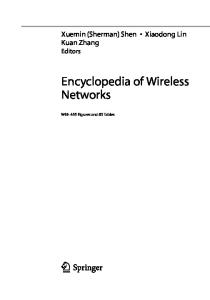Security Issues in Mobile NFC Devices
This work provides an assessment of the current state of near field communication (NFC) security, it reports on new attack scenarios, and offers concepts and solutions to overcome any unresolved issues. The work describes application-specific security asp
- PDF / 9,564,556 Bytes
- 193 Pages / 453.543 x 683.15 pts Page_size
- 69 Downloads / 326 Views
Michael Roland
Security Issues in Mobile NFC Devices
T-Labs Series in Telecommunication Services Series editors Sebastian Möller, Berlin, Germany Axel Küpper, Berlin, Germany Alexander Raake, Berlin, Germany
More information about this series at http://www.springer.com/series/10013
Michael Roland
Security Issues in Mobile NFC Devices
123
Michael Roland School of Informatics/Communications/Media University of Applied Sciences Upper Austria Hagenberg Austria
ISSN 2192-2810 ISSN 2192-2829 (electronic) T-Labs Series in Telecommunication Services ISBN 978-3-319-15487-9 ISBN 978-3-319-15488-6 (eBook) DOI 10.1007/978-3-319-15488-6 Library of Congress Control Number: 2015930733 Springer Cham Heidelberg New York Dordrecht London © Springer International Publishing Switzerland 2015 This work is subject to copyright. All rights are reserved by the Publisher, whether the whole or part of the material is concerned, specifically the rights of translation, reprinting, reuse of illustrations, recitation, broadcasting, reproduction on microfilms or in any other physical way, and transmission or information storage and retrieval, electronic adaptation, computer software, or by similar or dissimilar methodology now known or hereafter developed. The use of general descriptive names, registered names, trademarks, service marks, etc. in this publication does not imply, even in the absence of a specific statement, that such names are exempt from the relevant protective laws and regulations and therefore free for general use. The publisher, the authors and the editors are safe to assume that the advice and information in this book are believed to be true and accurate at the date of publication. Neither the publisher nor the authors or the editors give a warranty, express or implied, with respect to the material contained herein or for any errors or omissions that may have been made. Printed on acid-free paper Springer International Publishing AG Switzerland is part of Springer Science+Business Media (www.springer.com)
Preface
The recent emergence of Near Field Communication (NFC)-enabled smartphones led to an increasing interest in NFC technology and its applications by equipment manufacturers, service providers, developers, and end-users. Nevertheless, frequent media reports about security and privacy issues of electronic passports, contactless credit cards, asset tracking systems, NFC-enabled mobile phones, and proprietary contactless technologies suggest that NFC is a potentially unsafe technology whose main beneficiaries are thieves. While these weaknesses are often bound to specific applications and products, they boost the fear that NFC technology as a whole is dangerous, threatens our privacy, and helps identity theft and fraud. In order to defend their own products and services, manufacturers and service providers often position themselves on the opposite extreme, stating that their products and services incorporate sufficient countermeasures. This book is a revised version of my Ph.D. thesis. It is written for researc
Data Loading...











